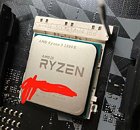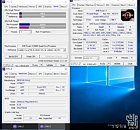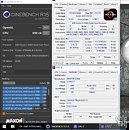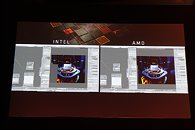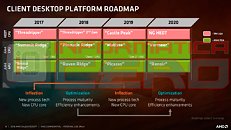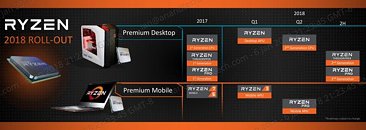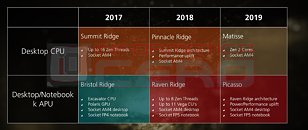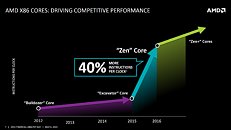Apr 18th, 2025 13:33 EDT
change timezone
Latest GPU Drivers
New Forum Posts
- RX 9000 series GPU Owners Club (388)
- Guess my potato specs (18)
- GPU Pricing and Performance (13)
- NVFlash for RTX 50 Series (Blackwell) (1)
- GPU Memory Temprature is always high (18)
- Looking for 4060 MXM-A VBIOS (6)
- SK hynix A-Die (Overclocking thread) only for RYZEN AM5 users (65)
- DTS DCH Driver for Realtek HDA [DTS:X APO4 + DTS Interactive] (2146)
- What's your latest tech purchase? (23571)
- Drives fail to work with Rufus Windows TO GO (1)
Popular Reviews
- ASUS GeForce RTX 5060 Ti TUF OC 16 GB Review
- NVIDIA GeForce RTX 5060 Ti PCI-Express x8 Scaling
- Palit GeForce RTX 5060 Ti Infinity 3 16 GB Review
- G.SKILL Trident Z5 NEO RGB DDR5-6000 32 GB CL26 Review - AMD EXPO
- ASUS GeForce RTX 5060 Ti Prime OC 16 GB Review
- Zotac GeForce RTX 5060 Ti AMP 16 GB Review
- MSI GeForce RTX 5060 Ti Gaming OC 16 GB Review
- Teevolution Terra Pro Review
- MSI GeForce RTX 5060 Ti Gaming Trio OC 16 GB Review
- ASUS GeForce RTX 5080 TUF OC Review
Controversial News Posts
- NVIDIA GeForce RTX 5060 Ti 16 GB SKU Likely Launching at $499, According to Supply Chain Leak (182)
- NVIDIA Sends MSRP Numbers to Partners: GeForce RTX 5060 Ti 8 GB at $379, RTX 5060 Ti 16 GB at $429 (127)
- Nintendo Confirms That Switch 2 Joy-Cons Will Not Utilize Hall Effect Stick Technology (105)
- Over 200,000 Sold Radeon RX 9070 and RX 9070 XT GPUs? AMD Says No Number was Given (100)
- Nintendo Switch 2 Launches June 5 at $449.99 with New Hardware and Games (99)
- NVIDIA Launches GeForce RTX 5060 Series, Beginning with RTX 5060 Ti This Week (98)
- Sony Increases the PS5 Pricing in EMEA and ANZ by Around 25 Percent (85)
- NVIDIA PhysX and Flow Made Fully Open-Source (77)
News Posts matching #Zen+
Return to Keyword Browsing
AMD Readying a 10-core AM4 Processor to Thwart Core i9-9900K?
To sustain its meteoric rise at the stock markets, AMD needs to keep investors convinced it has a competitive edge over Intel, even if it means investing heavily on short-term roadmap changes. According to an Elchapuzas Informatico article, AMD could be working on a new 10-core/20-thread processor for the AM4 platform, to compete with the upcoming Core i9-9900K 8-core/16-thread processor from Intel. The said processor is being labeled "Ryzen 7 2800X" and plastered over CineBench nT screenshots, where due to the sheer weight of its 10 cores, it tops the nT test in comparison to Intel's mainstream-desktop processors, including the 2P Xeon X5650 12-core/24-thread.
The Forbes article that cites the Elchapuzas Informatico, however, is skeptical that AMD could make such a short-sighted product investment. It believes that development of a 10-core die on existing "Zen+" architecture could warrant a massive redesign of the CCX (Zen Compute Complex), and AMD would only get an opportunity to do so when working on "Zen 2," which AMD still expects to debut by late-2018 on its EPYC product line. We, however, don't discount the possibility of a 10-core "Zen+" silicon just yet. GlobalFoundries, AMD's principal foundry partner for CPUs, has given up on 7 nm, making the company fall back to TSMC to meet its 7 nm roadmap commitments. TSMC already has a long list of clientele for 7 nm, including high-volume contracts from Apple, Qualcomm, and NVIDIA. This could force AMD to bolster its existing lineup as a contingency for delays in 7 nm volume production.
The Forbes article that cites the Elchapuzas Informatico, however, is skeptical that AMD could make such a short-sighted product investment. It believes that development of a 10-core die on existing "Zen+" architecture could warrant a massive redesign of the CCX (Zen Compute Complex), and AMD would only get an opportunity to do so when working on "Zen 2," which AMD still expects to debut by late-2018 on its EPYC product line. We, however, don't discount the possibility of a 10-core "Zen+" silicon just yet. GlobalFoundries, AMD's principal foundry partner for CPUs, has given up on 7 nm, making the company fall back to TSMC to meet its 7 nm roadmap commitments. TSMC already has a long list of clientele for 7 nm, including high-volume contracts from Apple, Qualcomm, and NVIDIA. This could force AMD to bolster its existing lineup as a contingency for delays in 7 nm volume production.

AMD Launches World's Most Powerful Desktop Processor: 2nd Generation Threadripper
AMD today announced the availability of world's most powerful desktop processor, the 2nd Gen AMD Ryzen Threadripper 2990WX processor with 32 cores and 64 threads. Designed to power the ultimate computing experiences, 2nd Gen AMD Ryzen Threadripper processors are built using 12 nm "Zen+" x86 processor architecture and offer the most threads on any desktop processor with the flagship model delivering up to 53% greater performance than the competition's flagship model. Second Gen AMD Ryzen Threadripper processors support the most I/O, and are compatible with existing AMD X399 chipset motherboards via a simple BIOS update, offering builders a broad choice for designing the ultimate high-end desktop or workstation PC.
"We created Ryzen Threadripper processors because we saw an opportunity to deliver unheard-of levels of multithreaded computing for the demanding needs of creators, gamers, and PC enthusiasts in the HEDT market," said Jim Anderson, senior vice president and general manager, Computing and Graphics Business Group, AMD. "With the 2nd Gen processor family we took that challenge to a whole new level - delivering the biggest, most powerful desktop processor the world has ever seen."
"We created Ryzen Threadripper processors because we saw an opportunity to deliver unheard-of levels of multithreaded computing for the demanding needs of creators, gamers, and PC enthusiasts in the HEDT market," said Jim Anderson, senior vice president and general manager, Computing and Graphics Business Group, AMD. "With the 2nd Gen processor family we took that challenge to a whole new level - delivering the biggest, most powerful desktop processor the world has ever seen."

First Benchmarks, Photo of AMD's Ryzen 3 2300X Surface
As AMD is moving closer towards completing its staggered Ryzen 2000 series' launch, first benchmarks and silicon photos have surfaced. AMD's Ryzen 3 2300X is a quad-core solution that leverages the Zen+ architecture on the 12 nm process, improving performance and power consumption over the original Ryzen 3 1300X. Alongside the new CPU line, AMD is also expected to refresh its chipset offerings, with a revised B450 superseding the B350 chipset - though users can drop in their Ryzen 2000 series processors on 300-series chipsets, provided they have the adequate BIOS already installed.
The Ryzen 3 2300X, paired with a BIOSTAR X370 motherboard, was put through its paces under CPU-Z (where it scored 509 and 2020 points in the single and multi-thread benchmarks respectively), as well as in Cinebench (where it scored 690 points). The 2300X can seemingly boost up to 4.2 GHz without any manual overclocking from its 3.5 GHz base clock - an improvement of around 500 MHz in the XFR-enabled boost over its predecessor, which only hit 3.7 GHz.
The Ryzen 3 2300X, paired with a BIOSTAR X370 motherboard, was put through its paces under CPU-Z (where it scored 509 and 2020 points in the single and multi-thread benchmarks respectively), as well as in Cinebench (where it scored 690 points). The 2300X can seemingly boost up to 4.2 GHz without any manual overclocking from its 3.5 GHz base clock - an improvement of around 500 MHz in the XFR-enabled boost over its predecessor, which only hit 3.7 GHz.

AMD Vega 20 GPU Could Implement PCI-Express gen 4.0
The "Vega 20" silicon will be significantly different from the "Vega 10" which powers the company's current Radeon RX Vega series. AMD CEO Dr. Lisa Su unveiled the "Vega 20" silicon at the company's 2018 Computex event, revealing that the multi-chip module's 7 nm GPU die is surrounded by not two, but four HBM2 memory stacks, making up to 32 GB of memory. Another key specification is emerging thanks to the sharp eyes at ComputerBase.de - system bus.
A close inspection of the latest AMDGPU Linux driver includes PCI-Express link speed definitions for PCI-Express gen 4.0, which offers 256 Gbps of bandwidth per direction at x16 bus width, double that of PCI-Express gen 3.0. "Vega 20" got its first PCIe gen 4.0 support confirmation from a leak slide that surfaced around CES 2018. AMD "Vega" architecture slides from last year hinted at a Q3/Q4 launch of the first "Vega 20" based product. The same slide also hinted that the next-generation EPYC processor, which we know are "Zen 2" based and not "Zen+," could feature PCI-Express gen 4.0 root-complexes. Since EPYC chips are multi-chip modules, it could also hint at the likelihood of PCIe gen 4.0 on "Zen 2" based 3rd generation Ryzen processor family.
A close inspection of the latest AMDGPU Linux driver includes PCI-Express link speed definitions for PCI-Express gen 4.0, which offers 256 Gbps of bandwidth per direction at x16 bus width, double that of PCI-Express gen 3.0. "Vega 20" got its first PCIe gen 4.0 support confirmation from a leak slide that surfaced around CES 2018. AMD "Vega" architecture slides from last year hinted at a Q3/Q4 launch of the first "Vega 20" based product. The same slide also hinted that the next-generation EPYC processor, which we know are "Zen 2" based and not "Zen+," could feature PCI-Express gen 4.0 root-complexes. Since EPYC chips are multi-chip modules, it could also hint at the likelihood of PCIe gen 4.0 on "Zen 2" based 3rd generation Ryzen processor family.

Prices of First-gen AMD Threadrippers Drop Like a Rock
Intel's strategy against AMD's unexpected doubling in core-counts of its Ryzen Threadripper HEDT processors has been that of a headless chicken in a room painted Vantablack. It announced a 28-core processor that would require you to buy a new motherboard; and is frantically working on a 22-core processor for the existing LGA2066 platform. It's looking like AMD isn't in a mood to walk into Intel's core-count trap, and could hit Intel where it hurts the most - pricing. The top-dog 32-core part has already reared its head on German web-stores, seeking a little over 1,500€, just 500€ more than the price its previous-generation 16-core flagship, the Threadripper 1950X launched at. At 1,500€-ish, AMD could end up disrupting Intel's entire >10-core lineup that's priced between $1199 to $1999, currently occupied by 12-core, 14-core, 16-core, and 18-core SKUs.
AMD may not spare Intel's sub-$1000 Core X lineup, either. Prices of first-generation Ryzen Threadripper processors are seeing a dramatic drop, with the flagship Threadripper 1950X being priced under 650€. Prices of the 12-core Threadripper 1920X have slipped to just under 550€. The Core i9-7900X, meanwhile, continues to command a touch over 880€. The drop in prices of first-gen Threadrippers is likely retailers trying to clear out inventories to make room for 2nd generation Threadrippers. It could also be a prelude to AMD announcing more affordable 12-core and 16-core Threadrippers based on the 2nd generation "Zen+" architecture.
AMD may not spare Intel's sub-$1000 Core X lineup, either. Prices of first-generation Ryzen Threadripper processors are seeing a dramatic drop, with the flagship Threadripper 1950X being priced under 650€. Prices of the 12-core Threadripper 1920X have slipped to just under 550€. The Core i9-7900X, meanwhile, continues to command a touch over 880€. The drop in prices of first-gen Threadrippers is likely retailers trying to clear out inventories to make room for 2nd generation Threadrippers. It could also be a prelude to AMD announcing more affordable 12-core and 16-core Threadrippers based on the 2nd generation "Zen+" architecture.

AMD to Polevault Zen+, Head Straight to 7nm Zen2 for EPYC
AMD in its Computex 2018 address earlier today, mention that its second-generation EPYC enterprise processors will be based on its 7 nanometer "Zen 2" architecture, and not 12 nm "Zen+." The company has the 7 nm silicon ready in its labs, and will begin sampling within the second half of 2018. The first products could launch in 2019, after validations. Besides improved energy-efficiency, the 12 nm "Zen+" architecture features a minor 3-5 percent IPC uplift thanks to improved multi-core clock-speed boosting, and faster caches. "Zen 2," on the other hand, presents AMD with the opportunity to make major design changes to its silicon to achieve higher IPC uplifts. The 7 nm process introduces significant transistor density uplifts over the current process. AMD is in the process of building 4-die multi-chip modules using the 12 nm "Pinnacle Ridge" silicon for its 2nd generation Ryzen Threadripper HEDT client processor family.

AMD Announces 2nd Generation Ryzen Threadripper with 32 Cores
AMD at its Computex 2018 presser unveiled the 2nd generation Ryzen Threadripper high-end desktop (HEDT) processors. These processors are multi-chip modules of four 12 nm 8-core "Pinnacle Ridge" dies, with up to 32 cores, and SMT enabling up to 64 threads. Much like the first-generation Threadripper family, there could be 16-core, 12-core, and 8-core SKUs; in addition to 24-core, 28-core, and 32-core ones. AMD did mention that these chips are backwards compatible with X399 motherboards, although it remains to be seen how AMD wires out the memory of two extra dies on the X399 platform. In all likelihood, there could be a new wave of motherboards that retain the TR4 socket with backwards-compatibility with 1st generation Threadripper proccessors, but having 8-channel memory slots.
The 2nd generation chips feature higher clock-speeds, and all of the "Zen+" features introduced by "Pinnacle Ridge," including Precision Boost II and XFR 2.0. AMD put up a demo of the chip challenging Intel's top-dog Core i9-7980XE, which has two more cores than it. This probably explains why Intel revealed a 28-core HEDT SKU yesterday. AMD stated that the lineup is en route Q3-2018 launch.
The 2nd generation chips feature higher clock-speeds, and all of the "Zen+" features introduced by "Pinnacle Ridge," including Precision Boost II and XFR 2.0. AMD put up a demo of the chip challenging Intel's top-dog Core i9-7980XE, which has two more cores than it. This probably explains why Intel revealed a 28-core HEDT SKU yesterday. AMD stated that the lineup is en route Q3-2018 launch.

AMD to Begin Sampling 7nm "Zen 2" Processors Within 2018 for a 2019 Launch
It looks like AMD's processor product launch cycle is on steroids, and keeping up (or even ahead) of Intel. After launching the first 12 nm processor architecture with "Zen+," the company is giving final touches to what it hopes to be the world's first 7 nanometer processor architecture, with "Zen 2." The company will reportedly begin sampling the chip within 2018, to enable volume production and market launch in 2019. Speaking at an investors conference call following the company's Q1-2018 Results release, AMD CEO Dr. Lisa Su confirmed the 7 nm roll-out strategy of her company.
"We have a 7nm GPU based on Vega that we'll sample later this year. We have a 7nm server CPU that we'll sample later this year. And then, obviously, we have a number of products that are planned for 2019 as well. So it's a very, very busy product season for us. But we're pleased with the sort of the execution on the product roadmap," Dr. Su said. Unlike Zen+, Zen 2 is a major update to the company's processor micro-architecture, and presents the company with opportunities to improve several silicon-level specifications, such as the number of cores per CCX, the IPC of each core, the core-count of the die, the cache hierarchy, and the overall energy-efficiency.
"We have a 7nm GPU based on Vega that we'll sample later this year. We have a 7nm server CPU that we'll sample later this year. And then, obviously, we have a number of products that are planned for 2019 as well. So it's a very, very busy product season for us. But we're pleased with the sort of the execution on the product roadmap," Dr. Su said. Unlike Zen+, Zen 2 is a major update to the company's processor micro-architecture, and presents the company with opportunities to improve several silicon-level specifications, such as the number of cores per CCX, the IPC of each core, the core-count of the die, the cache hierarchy, and the overall energy-efficiency.

AMD Announces Availability of 2nd Generation Ryzen "Pinnacle Ridge" Processors
AMD today announced the global availability of its 2nd Generation Ryzen Desktop processors, starting with four models optimized for gamers, creators, and hardware enthusiasts: Ryzen 7 2700X, Ryzen 7 2700, Ryzen 5 2600X, and Ryzen 5 2600 processors. Using the world's first 12 nm process technology, these 2nd Gen Ryzen processors can offer up to 15% higher gaming performance than 1st Gen Ryzen processors, while delivering the highest multiprocessing performance you can get on a mainstream desktop PC, and enhanced capabilities including Precision Boost 2 and Extended Frequency Range 2 (XFR 2), an included Wraith Cooler, unlocked performance accessed with the new Ryzen Master Utility, and more.
"Last year we started changing the PC industry with the introduction of our first wave of Ryzen processors - delivering more performance, features, and choice to our customers than before. Our 2nd Gen Ryzen CPUs continue this pursuit by raising the standards for enthusiast gamers and creators," said Jim Anderson, senior vice president and general manager, Computing and Graphics Business Group, AMD. "With this launch we're also demonstrating that we are just getting started, that we are committed to delivering a multi-generational roadmap of leadership high-performance processors that will drive innovation and competition into the industry for years to come."
"Last year we started changing the PC industry with the introduction of our first wave of Ryzen processors - delivering more performance, features, and choice to our customers than before. Our 2nd Gen Ryzen CPUs continue this pursuit by raising the standards for enthusiast gamers and creators," said Jim Anderson, senior vice president and general manager, Computing and Graphics Business Group, AMD. "With this launch we're also demonstrating that we are just getting started, that we are committed to delivering a multi-generational roadmap of leadership high-performance processors that will drive innovation and competition into the industry for years to come."

AMD Works on "Zen 5" Micro-architecture Already
AMD late Monday posted a video of key people associated with the company's successful Ryzen processor family, to walk down memory lane and stare into the future, on its official YouTube channel. Mike Clark, who holds the designation of Sr. Fellow Design Engineering at AMD, stated that he is "already working on Zen 5." Going by AMD's naming convention, the number next to "Zen" denotes major micro-architecture generation since "Zen" and any "+" following the number denotes refinement to a newer silicon fabrication node. "Zen+," for example, is a refinement of "Zen 1" or simply "Zen" to the newer 12 nm process, and allows AMD engineers to make minor improvements without any major design changes.
On the other hand, "Zen 2" presents AMD with the opportunity to bring about major design changes (think "more than 4 cores per CCX"), or even improvements within the core itself. "Zen 5" is hence the fifth major micro-architecture chance since "Zen," although it would be premature to call it "6th generation Ryzen," as there could be several "+" stopgaps between "Zen +" and "Zen 5." To ensure people don't dismiss Clark's words for a slip of the tongue, AMD even annotated "Yes, he said Zen 5, see Endnote," and in the Endnote that has a lot of CYA statements, confirmed that "Zen 5" is a legit internal code-name for a micro-architecture AMD is working on.The video follows.
On the other hand, "Zen 2" presents AMD with the opportunity to bring about major design changes (think "more than 4 cores per CCX"), or even improvements within the core itself. "Zen 5" is hence the fifth major micro-architecture chance since "Zen," although it would be premature to call it "6th generation Ryzen," as there could be several "+" stopgaps between "Zen +" and "Zen 5." To ensure people don't dismiss Clark's words for a slip of the tongue, AMD even annotated "Yes, he said Zen 5, see Endnote," and in the Endnote that has a lot of CYA statements, confirmed that "Zen 5" is a legit internal code-name for a micro-architecture AMD is working on.The video follows.

AMD Product Roadmap Slides for 2020 Leaked - "Castle Peak" TR4 and "Dali"
Continuing with its trend of leaking AMD slides, Spanish website Informatica Cero has now published some purported company slides leading up to AMD's 2020 strategy. New information concerns the appearance of a new, value-oriented mobile APU in the form of "Dali" - let's hope performance on that is slightly more predictable than the particular style of the artist whose name it follows. Dali therefore joins AMD's "Renoir" APU and "Vermeer" CPUs (both expected in the 7 nm process) for AMD's 2020 roadmap. This is an interesting product, which AMD is likely positioning for tablets and ultraportables.
Another interesting tidbit is AMD's outlook for their Threadripper line of HEDT CPUs. The company is looking towards its 7 nm rendition of these powerhouse chips, codenamed "Castle Peak", to bring them, in a literal way, to that figurative peak. AMD compares Threadripper to a Monster Truck of computing, and is apparently hoping to introduce Castle Peak as early as 2019. AMD then plans to further refine these "process inflection point" products in a new generation to come right after, in 2020 (much like the company has done now with Zen and Zen+).
Another interesting tidbit is AMD's outlook for their Threadripper line of HEDT CPUs. The company is looking towards its 7 nm rendition of these powerhouse chips, codenamed "Castle Peak", to bring them, in a literal way, to that figurative peak. AMD compares Threadripper to a Monster Truck of computing, and is apparently hoping to introduce Castle Peak as early as 2019. AMD then plans to further refine these "process inflection point" products in a new generation to come right after, in 2020 (much like the company has done now with Zen and Zen+).

AMD Reveals CPU, Graphics 2018-2020 Roadmap at CES
AMD at CES shed some light on its 2018 roadmap, while taking the opportunity to further shed some light on its graphics and CPU projects up to 2020. Part of their 2018 roadmap was the company's already announced, across the board price-cuts for their first generation Ryzen processors. This move aims to increase competitiveness of its CPU offerings against rival Intel - thus taking advantage of the blue giant's currently weakened position due to the exploit saga we've been covering. This move should also enable inventory clearings of first-gen Ryzen processors - soon to be supplanted by the new Zen+ 12 nm offerings, which are expected to receive a 10% boost to power efficiency from the process shrink alone, while also including some specific improvements in optimizing their performance per watt profile. These are further bound to see their market introduction in March, and are already in the process of sampling.
On the CPU side, AMD's 2018 roadmap further points towards a Threadripper and Ryzen Pro refresh in the 2H 2018, likely in the same vein as their consumer CPUs that we just talked about. On the graphics side of their 2018 roadmap, AMD focused user's attention in the introduction of premium Vega offerings in the mobile space (with HBM2 memory integration on interposer, as well), which should enable the company to compete against NVIDIA in the discrete graphics space for mobile computers. Another very interesting tidbit announced by AMD is that they would be skipping the 12 nm process for their graphics products entirely; the company announced that it will begin sampling of 7 nm Vega products to its partners, but only on the Instinct product line of machine learning accelerators. We consumers will likely have to wait a little while longer until we see some 7 nm graphics cards from AMD.
On the CPU side, AMD's 2018 roadmap further points towards a Threadripper and Ryzen Pro refresh in the 2H 2018, likely in the same vein as their consumer CPUs that we just talked about. On the graphics side of their 2018 roadmap, AMD focused user's attention in the introduction of premium Vega offerings in the mobile space (with HBM2 memory integration on interposer, as well), which should enable the company to compete against NVIDIA in the discrete graphics space for mobile computers. Another very interesting tidbit announced by AMD is that they would be skipping the 12 nm process for their graphics products entirely; the company announced that it will begin sampling of 7 nm Vega products to its partners, but only on the Instinct product line of machine learning accelerators. We consumers will likely have to wait a little while longer until we see some 7 nm graphics cards from AMD.

AMD's Pinnacle Ridge Zen+ 12 nm CPUs to Launch on February 2018
A recent AMD roadmap leak showed the company's "tick", process-improved plans for 2018's Zen+, as well as its painter-imbued aspirations with Zen 2 in 2019. Now, there's some new info posted by DigiTimes that's being sourced straight from motherboard makers that points to the company's Pinnacle Ridge launch being set sometime in February 2018.
This information seems to have been delivered to the motherboard makers straight from AMD itself, as a heads-up for when they should be expecting to ramp up production of next-generation chipsets. Sources report that AMD will follow their Summit Ridge, Ryzen launch, with the initial release of Pinnacle 7 in February, followed by the mid-range Pinnacle 5 and entry-level Pinnacle 3 processors in March 2018. DigiTimes also reports that AMD is expecting to see its share of the desktop CPU market return to at least 30% in the first half of 2018 which, coeteris paribus, is more of a simple mathematical progression than clarvoyance.
This information seems to have been delivered to the motherboard makers straight from AMD itself, as a heads-up for when they should be expecting to ramp up production of next-generation chipsets. Sources report that AMD will follow their Summit Ridge, Ryzen launch, with the initial release of Pinnacle 7 in February, followed by the mid-range Pinnacle 5 and entry-level Pinnacle 3 processors in March 2018. DigiTimes also reports that AMD is expecting to see its share of the desktop CPU market return to at least 30% in the first half of 2018 which, coeteris paribus, is more of a simple mathematical progression than clarvoyance.

AMD to Detail Vega, Navi, Zen+ on May 16th - Laying Out a Vision
Reports are circling around the web regarding an AMD meeting featuring some of its higher ups - namely, CEO Lisa Su, head of Radeon Technologies Group Raja Koduri, and AMD's CTO Mark Papermaster happening on the 16th of May. The purpose of this meeting seems to be to discuss AMD's inflexion point, and lay out a vision for the company's future, supported on its upcoming products: the too-long-awaited Vega, its successor Navi, and the natural evolution of the company's current Zen processors, tentatively identified as Zen+.
Naturally, a company such as AMD has its roadmap planned well in advance, with work on next-generation products and technologies sometimes even running in parallel with current-generation product development. It's just a result of the kind of care, consideration, time and money that goes into making new architectures that makes this so. And while some would say Vega is now approaching a state akin to grapes that have been hanging for far too long, AMD's next graphics architecture, Navi, and its iterations on Zen cores, which the company expect to see refreshes in a 3-to-5-year period, are other matters entirely. Maybe we'll have some more details regarding the specific time of Vega's launch (for now expected on Computex), as well as on when AMD is looking to release a Zen+ refresh. I wouldn't expect much with regards to Navi - perhaps just an outline on how work is currently underway with some comments on the expectations surrounding Global Foundries' 7 nm process, on which Navi is expected to be built. And no, folks, this isn't a Vega launch. Not yet.
Naturally, a company such as AMD has its roadmap planned well in advance, with work on next-generation products and technologies sometimes even running in parallel with current-generation product development. It's just a result of the kind of care, consideration, time and money that goes into making new architectures that makes this so. And while some would say Vega is now approaching a state akin to grapes that have been hanging for far too long, AMD's next graphics architecture, Navi, and its iterations on Zen cores, which the company expect to see refreshes in a 3-to-5-year period, are other matters entirely. Maybe we'll have some more details regarding the specific time of Vega's launch (for now expected on Computex), as well as on when AMD is looking to release a Zen+ refresh. I wouldn't expect much with regards to Navi - perhaps just an outline on how work is currently underway with some comments on the expectations surrounding Global Foundries' 7 nm process, on which Navi is expected to be built. And no, folks, this isn't a Vega launch. Not yet.
Apr 18th, 2025 13:33 EDT
change timezone
Latest GPU Drivers
New Forum Posts
- RX 9000 series GPU Owners Club (388)
- Guess my potato specs (18)
- GPU Pricing and Performance (13)
- NVFlash for RTX 50 Series (Blackwell) (1)
- GPU Memory Temprature is always high (18)
- Looking for 4060 MXM-A VBIOS (6)
- SK hynix A-Die (Overclocking thread) only for RYZEN AM5 users (65)
- DTS DCH Driver for Realtek HDA [DTS:X APO4 + DTS Interactive] (2146)
- What's your latest tech purchase? (23571)
- Drives fail to work with Rufus Windows TO GO (1)
Popular Reviews
- ASUS GeForce RTX 5060 Ti TUF OC 16 GB Review
- NVIDIA GeForce RTX 5060 Ti PCI-Express x8 Scaling
- Palit GeForce RTX 5060 Ti Infinity 3 16 GB Review
- G.SKILL Trident Z5 NEO RGB DDR5-6000 32 GB CL26 Review - AMD EXPO
- ASUS GeForce RTX 5060 Ti Prime OC 16 GB Review
- Zotac GeForce RTX 5060 Ti AMP 16 GB Review
- MSI GeForce RTX 5060 Ti Gaming OC 16 GB Review
- Teevolution Terra Pro Review
- MSI GeForce RTX 5060 Ti Gaming Trio OC 16 GB Review
- ASUS GeForce RTX 5080 TUF OC Review
Controversial News Posts
- NVIDIA GeForce RTX 5060 Ti 16 GB SKU Likely Launching at $499, According to Supply Chain Leak (182)
- NVIDIA Sends MSRP Numbers to Partners: GeForce RTX 5060 Ti 8 GB at $379, RTX 5060 Ti 16 GB at $429 (127)
- Nintendo Confirms That Switch 2 Joy-Cons Will Not Utilize Hall Effect Stick Technology (105)
- Over 200,000 Sold Radeon RX 9070 and RX 9070 XT GPUs? AMD Says No Number was Given (100)
- Nintendo Switch 2 Launches June 5 at $449.99 with New Hardware and Games (99)
- NVIDIA Launches GeForce RTX 5060 Series, Beginning with RTX 5060 Ti This Week (98)
- Sony Increases the PS5 Pricing in EMEA and ANZ by Around 25 Percent (85)
- NVIDIA PhysX and Flow Made Fully Open-Source (77)


